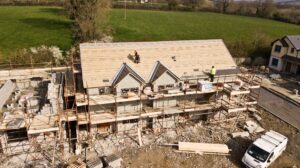
The Importance of the International Building Code
The International Building Code (IBC) serves as the basis for the Family of International Codes. The purpose of this document is to make sure that the health and safety of the public is properly preserved. The IBC offers protection from hazards that typically occur in the constructed environment. It also addresses the installation and design of modern materials that exceed health and safety goals.
This code was put in place by the International Code Council (ICC) and has been adopted as the base standard by the majority of jurisdictions throughout the U.S. Even though the IBC contains 35 chapters, it’s wholly compatible with the many other ICC codes that have been published.
The provisions in this document are designed to maintain public health and safety while at the same time avoiding unnecessary expenses. The code is also updated in three-year intervals. In this guide, you’ll learn about the importance of the International Building Code and what it means for construction projects.

Overview of the International Building Code
Much of the International Building Code focuses on fire prevention. While the ICC already maintains an International Fire Code, the main difference is that the IBC is specifically centered around fire prevention that pertains to construction and design processes. In comparison, the fire code is used to provide safety regulations for the operation of an occupied building that’s already been built.
In the IBC, you’ll be given criteria for the size, location, and number of exits that must be present in a building design. The fire code includes guidelines that state that any exits in the building need to be unlocked. The IBC also offers guidelines for structural stability and accessibility for individuals with disabilities. This code is applicable to almost every structure in jurisdictions where it’s adopted. The only exceptions include one and two family dwellings.
A portion of this code mentions other codes that are found in the International Mechanical Code, International Plumbing Code, National Fire Protection Association standards, and National Electric Code. In the event that a municipality decides to adhere to the IBC, it will need to adopt aspects of other codes that are mentioned in the IBC document. The IBC document contains more than 700 pages across 35 chapters that focus on everything from building heights and areas to fire protection systems.
History, Development, and Maintenance
Since the beginning of the 20th century, building regulations throughout the U.S. have been based on building codes that were developed by regional model code groups and eventually adopted by state and local governments. For instance, the codes created by the Building Official Code Administrators International (BOCA) were adopted along the East Coast and Midwest regions of the U.S.
In 1972, the three regional model code groups formed the Council of American Building Officials (CABO) in order to develop a national building code that would serve as the base guidelines for any type of residential construction. It wasn’t until 1994 that these three groups merged together to create the International Code Council (ICC) to form an extensive list of building codes that wouldn’t have regional limitations.
The formation of the International Code Council was promoted by American construction manufacturers and professionals to deliver a building code that everyone would be able to use. Before then, manufacturers and professionals would waste considerable time and money needing to comply with different regional codes. The initial edition of this code was published for the U.S. in 2000. Since that time, a new and refined edition has been published in three-year intervals.

Every ICC Building Code
The International Building Code that’s maintained by the ICC contains 35 distinct chapters, each of which has numerous sections. The chapters available in the International Building Code include:
- Scope and Administration – This chapter establishes how the code will be enforced.
- Definitions – In this chapter, the ICC outlines definitions on some of the more common terms used in the document.
- Occupancy Classification and Use – The criteria from which structures and buildings are classified is detailed in this chapter.
- Special Detailed Requirements Based on Occupancy and Use – Information on occupancy and special uses for different buildings is provided in this chapter.
- General Building Heights and Areas – A list of recommended building heights and area specifications is outlined here.
- Types of Construction – There are five types of construction that buildings can be classified with.
- Fire and Smoke Protection Features – Instructions for using fire-resistant materials and construction practices are provided here.
- Interior Finishes – Fire protection requirements for interior materials and finishes are described in this chapter.
- Fire Protection and Life Safety Systems – The minimum requirements for detecting a fire are listed in this chapter and are based on the height and occupancy of the building.
- Means of Egress – This chapter tells developers how to design the means of egress.
- Accessibility – This chapter centers around the accessibility features that every building must have to accommodate individuals with disabilities.
- Interior Environment – In this chapter, minimum provisions for building interiors are detailed.
- Energy Efficiency – This chapter aims to provide construction companies and builders with recommendations on energy-efficient building materials and systems to use.
- Exterior Walls – Exterior wall specifications are outlined here.
- Roof Assemblies and Rooftop Structures – The necessary specifications for rooftop structures and assemblies are available in this chapter.
- Structural Design – The most important structural design elements for different categories of buildings are available in this chapter.
- Special Inspections and Tests – All necessary inspections and tests during the construction process are described here.
- Soils and Foundations – Recommendations on how a property’s foundation and soil should be taken into account during construction are listed in this chapter.
- Concrete – This chapter highlights best building practices for concrete.
- Aluminum – This chapter highlights best building practices for aluminum.
- Masonry – This chapter highlights best building practices for masonry.
- Steel – This chapter highlights best building practices for steel.
- Wood – This chapter highlights best building practices for wood.
- Glass and Glazing – Regulations for glass and glazing products are established in this chapter.
- Gypsum Board, Gypsum Panel Products, and Plaster – This chapter details the current standards on how to use gypsum board and gypsum panel products.
- Plastic – All established building codes for plastic are outlined in this chapter.
- Electrical – This chapter focuses on the installation and protection of electrical systems.
- Mechanical Systems – This chapter focuses on the installation and protection of mechanical systems.
- Plumbing Systems – This chapter focuses on the installation and protection of plumbing systems.
- Elevator and Conveyor Systems – Guidelines for elevator and conveyor systems are outlined in this chapter.
- Special Construction – Regulations for unique building elements are included in this chapter. These elements extend to everything from vehicular gates to solar energy systems.
- Encroachments into the Public Right-of-Way – Parameters for all property encroachments are available in this chapter.
- Safeguards During Construction – This chapter provides construction crews and developers with safeguards they should implement on the construction site.
- Reserved – This chapter was removed in 2012 but is reserved for future use.
- Referenced Standards – This chapter includes references to all of the other building standards that were detailed in the International Building Code.

Benefits of the IBC
There are numerous benefits associated with adopting the standards maintained by the IBC, the primary of which include:
- The code results in designs that are highly efficient. They also provide flexibility for the architect, designer, engineer, and code official.
- Code provisions promote the use of smart and advanced forms of technology.
- This code focuses on engineered and prescriptive solutions while also allowing the use of standard construction methods that companies and professionals still use.
- The principles within the code are based on making sure that the public health, welfare, and safety are protected.
- This code references other nationally developed standards.
Today’s IBC is Known For
The current IBC has some primary focuses that are particularly important in modern construction. These focuses include:
- Correlation – The code is correlated to the work done in the ICC’s other codes.
- Safety – This set of guidelines has a track record of providing sanitary and safe plumbing installations.
- Embracing new technology – The code and all versions that have come before traditionally include innovative technologies that will make the construction process safer and more efficient.
- Ease of use – This code uses the simple format that every I-code uses.
- Open and honest development process – The code is revised every three years via the reputable consensus code development process that involves the expertise of many building, safety, and plumbing experts across the U.S.

Effective Use of the IBC
As shown above, the building codes that are present in the IBC include guidelines and regulations for every facet of the construction process. Builders and construction companies can reference these codes during the design and construction stages to make sure that their buildings are up to code. Over the years, nearly every jurisdiction throughout the country has adopted the IBC, which means that your building might not be up to code if it doesn’t adhere to the guidelines written in the IBC document.
The International Building Code has proven to be a highly effective document because of its ability to promote new building designs and materials. While the document is lengthy, each chapter is separated into numerous sections that make it easier to design a building that meets the IBC standards.

Jason Somers, President & Founder of Crest Real Estate
With over 15 years of professional experience in the Los Angeles luxury real estate market, Jason Somers has the background, judgement and track record to provide an unparalleled level of real estate services. His widespread knowledge helps clients identify and acquire income producing properties and value-ad development opportunities.
Learn more about Jason Somers or contact us.



